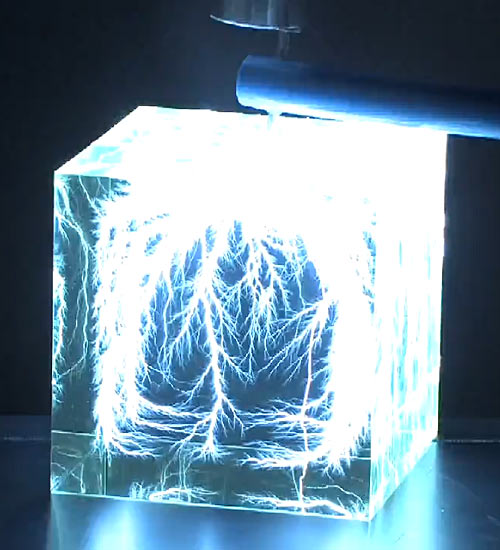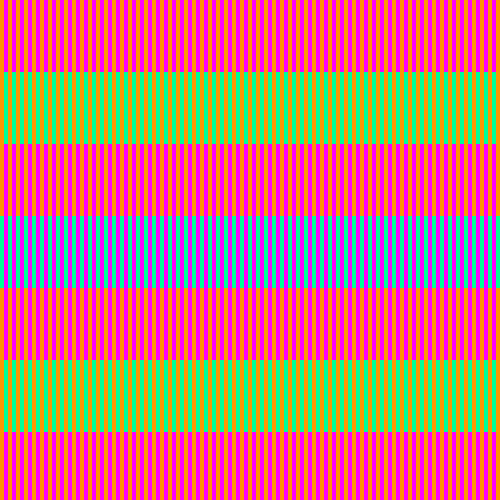
In which Theo Gray makes some acrylic Lichtenberg figures rather bigger than the ones I can afford.

More detail in these excerpts from his book.
(Via.)

In which Theo Gray makes some acrylic Lichtenberg figures rather bigger than the ones I can afford.

More detail in these excerpts from his book.
(Via.)
Here's a killer optical illusion for you:
The "green" and "blue" spirals in this image are actually the same colour. It's like the classic same colour illusion, except, you know, colourful.
(I don't know how this illusion will affect people with one or another kind of colour-blindness. Please comment if you don't see the effect, so the rest of us can all float theories about why you're so weird and unlovable.)
After marveling at this for a while, I spent 15 minutes straightening the illusion out into parallel stripes:

As you can see, it still works.
If you look closely, you can see that the leftmost and rightmost "blue" vertical stripes look distinctly greener than the rest of the "blue" stripes, because they're only flanked by magenta on one side. But they still look pretty blue, despite being exactly the same colour as the "green" stripes.
There are only three colours in this image - magenta, orange and green.
I await with interest the bizarre innovation that'll cause me to undergo the mental inversion so many people suffer, which leads one to conclude that The Stuff The Kids Listen To These Days, It's Just Noise, Not Like Bach/Haydn/Britten/Miles Davis/The Beastie Boys.
This leads me into thinking about the nature of art.
Thus far, I have concluded that art is whatever someone is pointing at when they say "that's art!"
Here are some of my other provisional conclusions:
"Bad art" is not the same as "not art".
"Low art" is not the same as "not art".
Art is still art even if it's easy to make.
Art is still art even if it makes its lazy and/or incompetent creator a lot of money.
Art is still art even if you don't know what it's supposed to be.
Art is still art even if you don't understand how it's made.
Art is still art even if it's not very original.
Art is still art even if you personally don't like it.
Art is still art even if unpleasant people made it.
Art is still art even if unpleasant people like it.
Art is still art even if the people who made it and/or like it are wankers.
Art is still art even if nobody seems to like it.
Art is still art even if it was created as a joke.
Art is still art even if it is the product of fraud.
Art is still art even if it's made by a machine.
Art is still art even if it's not entertaining.
Art is still art even if it is entertaining.
The other day I was shining a dangerously bright green laser through a Lichtenberg figure, as I'm sure all of you have done from time to time, and I discovered something interesting.
What?
Oh, all right. I'll explain.
This is a Lichtenberg figure.
Well, technically, the Lichtenberg figure is the feathery ferny shape inside the block of clear acrylic. The shape is a void burned into the plastic by a powerful electric discharge.
A Lichtenberg figure is, in brief, the shape of an electrical discharge. Specifically, it's the shape of an electrical discharge from an area to a point - sometimes over time, but usually all at once.
The acrylic-block type of Lichtenberg ornament is definitely of the all-at-once variety. To make one, you have to shoot your acrylic with a fairly high powered electron beam, also known as a cathode ray.
The electron beam in a Cathode Ray Tube (CRT) television or computer monitor - which, yes, actually is a kind of particle accelerator - delivers electrons with maybe 20,000 or 25,000 electron volts (20 to 25keV) of energy.
That's quite enough to produce considerable X-ray radiation when the electrons strike the inside of the tube - which is why CRTs are made from leaded, radiation-blocking glass - but it's only 1%, at best, of the energy you need to drive electrons even a centimetre or so into a plastic target.
If your electron beam is powerful enough to do that, several seconds of exposure will cause the plastic to acquire a absolutely terrific level of charge. Up in the low megavolts, and with total stored energy ranging from that of a tiny to that of a quite large pistol cartridge.
Then you bring an earthed contact close to one side of the block.
And bang, there's your Lichtenberg figure.
It's been speculated that the feathery tips of the figure are present all the way down to the molecular level.
The world's premiere - actually, pretty close to the world's only - supplier of Lichtenberg figures burned into clear acrylic blocks is Bert Hickman's Stoneridge Engineering. That's one of Bert's in the video above, and I've bought a total of three smaller figures from him over the years, from his eBay store here. This equilateral triangle figure is four inches on a side, and cost me $US24.95 plus postage.
As acrylic Lichtenberg figures get bigger, the energy needed to make them rises, and is soon well beyond what your common-or-garden medical LINAC can manage. This sort of accelerator is not something you can make at home; it's very difficult to get even 1MeV out of a homebuilt unit, even if you're the kind of kid who is only bullied by the members of the football team who didn't know about all the jocks at your old school whose hair and teeth fell out before they died.
You need something like one of the big blighters used to irradiate food. This is why Bert's real monsters are rather expensive.
When high energy electrons hit acrylic, they don't just settle peacefully into the polymer matrix. They actually hit hard enough to discolour the plastic on the side on which the beam enters. This effect is known as "solarisation", because it looks not unlike the discolouration caused by long exposure to ultraviolet radiation (which only has energy of about ten electron-volts).
The electrons actually end up charging the plastic a bit beyond the discoloured deceleration zone. So if you look at an acrylic Lichtenberg figure from the side...
...you can quite clearly see the discoloration and the Lichtenberg figure itself as separate layers.
The solarisation nestles around the Lichtenberg figure like a little bathtub. It fades out around the edges, but those edges rise up around the lightning-shape on all sides.
And this is what I noticed when I was fooling around with my laser.
Shining the laser through the un-solarised part of the figure...
...produced pretty much the effect you'd expect.
But shining it through the solarised portion...
...gave a, much brighter, amber diffusion glow. You can see the beam turning amber as it hits the solarised portion of the plastic.
There's no great mystery about why the beam looks brighter in the solarised area. That seems to simply be because it's travelling through damaged polymer that scatters more of the light.
But the distinct amber colour was a surprise.
Only the scattered light is amber; the main beam's the same colour coming out of the block as it was going in.
Here's the unsolarised side, again.
Another interesting thing about solarisation is that it heals. Over a few years, if you don't expose the acrylic to any more high-energy insults, the orange tint goes away.
The first Lichtenberg figure I bought from Bert was a little two-incher, which I purchased back in 2004. I can't remember whether it had visible solarisation when I got it, but it doesn't now - and a green laser beam stays green all the way through it.
UPDATE: Find some high-res video of acrylic Lichtenberg figures being made in this post!
Apropos my stitching up of Will Self's office, here is M.C. Escher's Hand With Reflecting Sphere, unwrapped into a Quicktime VR panorama.
(I originally wrote the artist's name as "MC Escher", then realised that looked as if he should have been performing with the Furious Five or something. "I'm MC Escher and I'm here to say, the stairs go up and down today! Get up! Get down! Get up! Get down!...")
Stelarc is everything the famous-in-certain-circles Kevin Warwick would be, if Kev had more guts and less self-promotion.
I base this evaluation on the fact that Stelarc does bowel-clenchingly freaky things to himself and says he's an artist, while Warwick does things any schmuck could do and calls himself a researcher.
It's probably best that those of a delicate disposition not click the above, or look at this later picture either.
I think Stelarc's a bit like Survival Research Laboratories would be, if everything they made had to pass through their bodies somewhere.
Further evidence: Kevin Warwick has said wanky things about Stelarc, but I don't think Stelarc's said anything about Kevin.
I don't know about you, but the obvious question that popped into my mind when I discovered that there's "A 360 degree view in 71 photos of Will Self's writing room" on Self's site was "what'll happen if you feed those photos into panorama stitching software?"
Ta-daaah.
(If clicking on the above image doesn't work because Coral isnt' answering hails, here's the direct link.)
Lots of the images don't actually match up, but Autostitch knows to discard the puzzle pieces that don't fit. The result also has quite a few dreamy spots in it, like any close-range indoor hand-held panorama. But, y'know, that's just a bit cubist, innit?
It's still not half bad, if you ask me.
...make it Code Guardian, from Cee-Gee (who're Italian, hence odd voice acting). Their download server is currently a melted lump, but there are mirrors.
Someone on the Metafilter thread about this video wondered where the British robot was.
Personally, I want to see the Soviet one, stonewalling the Wehrmacht at Stalingrad, long since out of ammo for all eight guns and just pounding on Panthers with a length of I-beam.
2010 UPDATE: In the time since this post first went up, the Cee-Gee site has fallen into a state of disrepair, and no longer has the clips available for download. You can, as of January 2010, still find the high-res version of Code Guardian here on ausgamers.com.